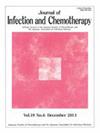人类爱知病毒的全球流行病学、基因型分布和合并感染率:系统综述。
IF 1.9
4区 医学
Q3 INFECTIOUS DISEASES
引用次数: 0
摘要
背景急性肠胃炎是各年龄段人群的主要健康问题,每年造成 250 多万五岁以下儿童死亡。人类爱知病毒会引起急性肠胃炎,并与食源性疾病暴发有关。本研究旨在描述 AiV-1 的全球血清流行率及其基因型分布,追踪疫情爆发情况,并估算与其他病毒性肠胃炎的合并感染率。方法对 AiV-1 的流行病学方面进行了全面的系统检索,检索对象为自日本首次检测到该病毒以来至 2022 年 10 月在多个科学数据库库中收录的经同行评审的英文原创文章。结果AiV-1 的全球流行率为 1.45%。自 1987 年至 1991 年日本首次爆发与牡蛎有关的疫情后,迄今为止共报告了九次 AiV-1 疫情。AiV-1 基因型 A 分布于世界各地,而基因型 B 和 C 则具有地理定位模式。所有研究都表明,随着年龄的增长,AiV-1 的血清流行率会逐渐显著上升。在 AiV-1 感染者中,导致病毒合并感染的最主要病毒是诺罗病毒(36.55%)、轮状病毒(18.91%)和沙波病毒(15.13%)。诺罗病毒(p 值为 0.003)、轮状病毒(p = 0.007)和人类天花病毒(p = 0.032)合并感染与 AiV-1 合并感染显著相关。尽管 AiV-1 在全球的流行率较低,但由于它与儿童肠胃炎有关,因此可被视为一种健康问题。本文章由计算机程序翻译,如有差异,请以英文原文为准。
Global epidemiology, genotype distribution and coinfection rate of Human Aichi virus: A systematic review
Background
Acute gastroenteritis is a major health concern for all age groups and accounts for more than 2.5 million deaths annually in children under five years old. Human Aichi virus causes acute gastroenteritis and is associated with foodborne outbreaks. Little is known about its pathogenicity, evolution, and geographical distribution.
Objective
This study aimed to describe the global seroprevalence of AiV-1 and its genotype distribution, track outbreaks, and estimate co-infection rates with other viral gastroenteritis.
Methods
A comprehensive systematic search of the epidemiological aspects of AiV-1 was conducted using peer-reviewed English original articles indexed in several scientific database libraries since its first detection in Japan until October 2022. A total of 55 published studies were included in the final analysis based on the inclusion criteria.
Result
The global prevalence of AiV-1 was 1.45 %. To date, nine AiV-1 outbreaks were reported following the first oyster-associated outbreak in Japan between 1987 and 1991. AiV-1 genotype A has a worldwide distribution, whereas genotypes B and C have a pattern of geo-localization. The gradual and significant increase of AiV-1 seroprevalence with age was reported in all studies. The most predominant viruses causing viral coinfection among AiV-1-infected patients were Norovirus (36.55 %), Rotavirus (18.91 %), and Sapovirus (15.13 %). Coinfections with Norovirus (p-value 0.003), Rotavirus (p = 0.007), and Human Astrovirus (p = 0.032) were significantly correlated with AiV-1 coinfection.
Conclusion
This was the first comprehensive systematic review of AiV-1. Although AiV-1 has a low global prevalence, it can be considered a health concern due to its association with childhood gastroenteritis.
求助全文
通过发布文献求助,成功后即可免费获取论文全文。
去求助
来源期刊

Journal of Infection and Chemotherapy
INFECTIOUS DISEASES-PHARMACOLOGY & PHARMACY
CiteScore
4.10
自引率
4.50%
发文量
303
审稿时长
47 days
期刊介绍:
The Journal of Infection and Chemotherapy (JIC) — official journal of the Japanese Society of Chemotherapy and The Japanese Association for Infectious Diseases — welcomes original papers, laboratory or clinical, as well as case reports, notes, committee reports, surveillance and guidelines from all parts of the world on all aspects of chemotherapy, covering the pathogenesis, diagnosis, treatment, and control of infection, including treatment with anticancer drugs. Experimental studies on animal models and pharmacokinetics, and reports on epidemiology and clinical trials are particularly welcome.
 求助内容:
求助内容: 应助结果提醒方式:
应助结果提醒方式:


